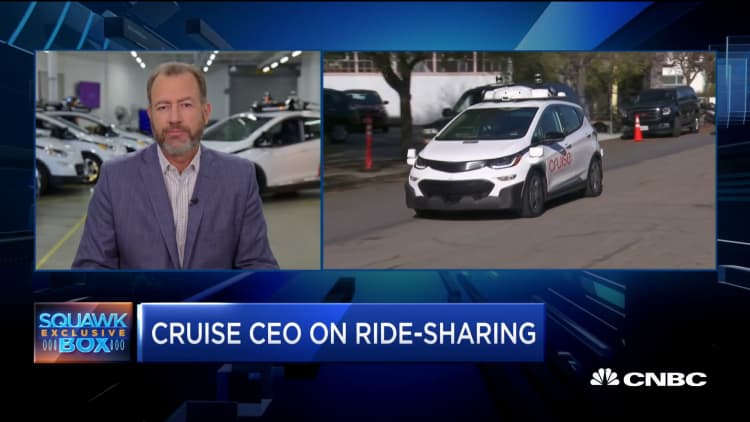Cruise, a majority-owned subsidiary of General Motors, debuted its first vehicle specifically designed to operate without a driver on board at an event in San Francisco on Tuesday night.
The driverless, electric shuttle, which GM is calling Origin, does not have manual controls such as pedals or a steering wheel.
"It is self-driven. It is all electric. It is shared. It is a production vehicle," Cruise CEO Dan Ammann said.
Kyle Vogt, Cruise's founder, president and CTO, demonstrated the vehicle's design and technology.
He first showed off the doors, which part rather than swing out to open, and the vehicle's seats, which offer at least as much legroom as "extra legroom" seats on an airplane, he said. He also showed a video of sensors that function as the vehicle's eyes, and rotate, much like an owl's head, to help the car perceive what's going on around it.
Ammann had alluded to a shuttle-like vehicle, offering more interior space than a traditional car, in a Medium post last month called "We need to move beyond the car."
Cruise's current self-driving test fleet is based on GM's all-electric Chevrolet Bolt EV. One iteration of the car unveiled in January 2018 included no manual controls but maintained the car's traditional interior.
Tuesday's event comes six months after Cruise delayed the launch of a commercial, self-driving vehicle service in San Francisco, which it had expected to deploy in 2019. The company said its vehicles required further testing.
Ammann, formerly president of GM, and GM CEO Mary Barra have said the launch of the company's self-driving vehicles would be "gated by safety." The postponement was an example of the technical and regulatory difficulties companies face in making truly driverless vehicles into a reality.
On Tuesday, Cruise did not give a specific timeline for start of production for Origin.

While many believe autonomous vehicles can save lives, some have been skeptical about allowing the vehicles on public roads — particularly following a fatal crash involving a self-driving Uber vehicle in March 2018 in Arizona.
GM first announced its plans to develop a "purpose-built" self-driving vehicle in October 2018 as part of a deal with Honda Motor, which agreed to invest $2.75 billion in Cruise. The tie-up gave the Japanese automaker a 5.7% stake in Cruise for the investment, which included an immediate $750 million and another $2 billion for development and deployment of self-driving vehicles over the next 12 years.
'First-mover advantage'
GM executives have touted a "first-mover advantage" in autonomous vehicles and have made ambitious financial projections for the industry.
In 2017, when announcing plans for the commercial robotaxi service for 2019, GM said its autonomous vehicle business could potentially eclipse the profits it earns in its core automotive business in the 2020s. Then-GM CFO Chuck Stevens said a driverless-car service by 2025 could offer 20% to 30% margins and a "total addressable market of several hundreds of billions of dollars."
At the time, GM's launch cadence was viewed as ambitious against its traditional rivals as well as emerging competitors such as Tesla and Alphabet's Waymo.
Cruise has permission to test driverless vehicles on public roads in California only if they have a human safety driver on board. But unlike competitors including Waymo, Pony.ai, AutoX and Zoox, Cruise has not secured permits to test driverless vehicles on California's roads without that safety driver.
Waymo has been arguably the most successful in launching autonomous vehicles. It has operated a limited ride-hailing fleet with the vehicles in metropolitan Phoenix since December 2018.
On an Oct. 24 earnings call in 2019, Tesla CEO Elon Musk assured shareholders that the company was on track for "early access release of a fully functional full self-driving" vehicle by the end of the year. The company failed to update that delivery timeline in 2019 but is expected to shine a light on its autonomous vehicle plans on an earnings call scheduled for Jan. 29.
Other companies have announced targets in the early part of this decade. Ford Motor expects a commercial self-driving vehicle business by 2021. Hyundai Motor with auto supplier Aptiv created a $4 billion joint venture that aims to launch autonomous vehicles in 2022.
Cruise has raised $7.25 billion from investors including Honda, SoftBank Vision Fund and T. Rowe Price Associates. The latest investments, announced in May 2019, valued the company at $19 billion.



